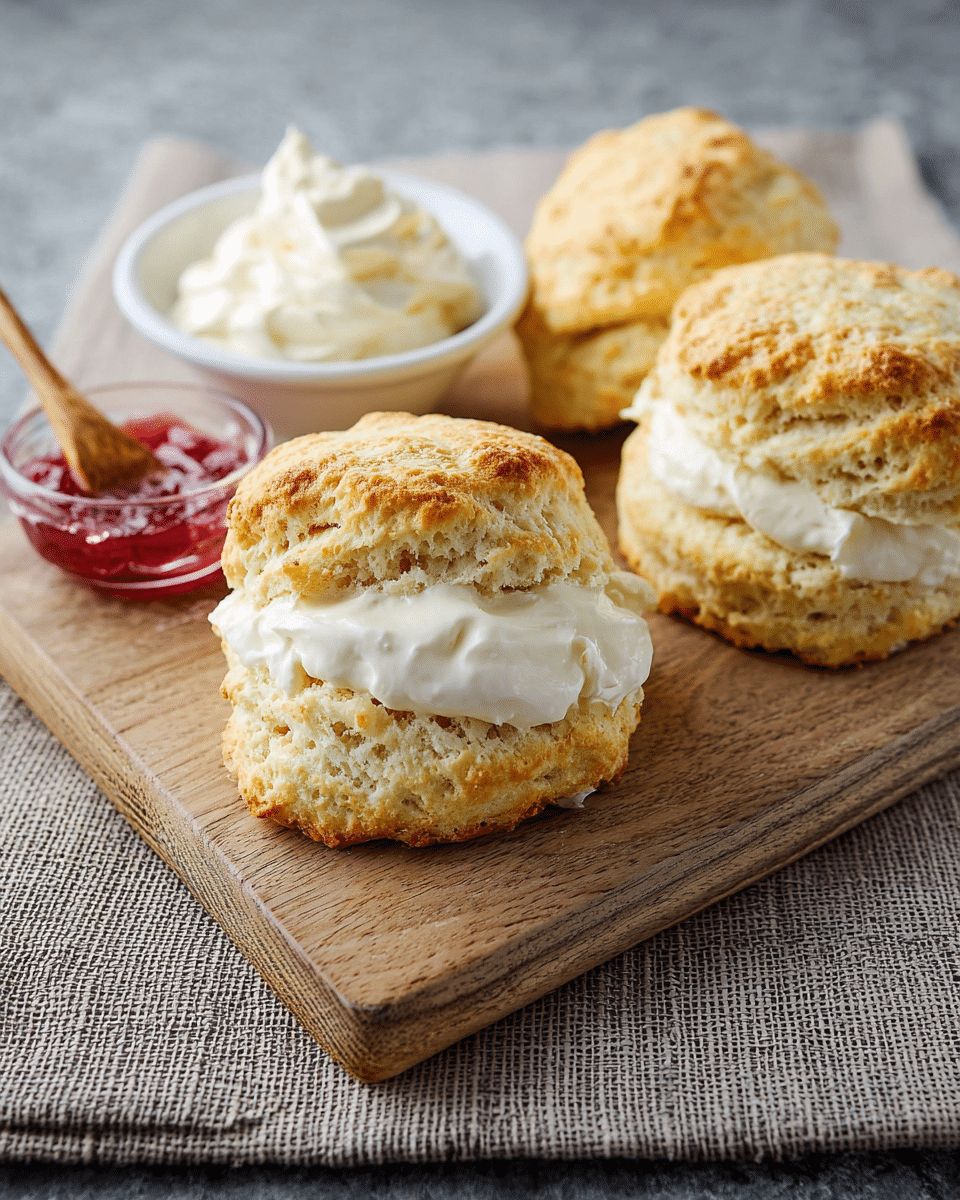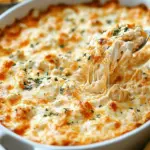The scent of buttery, fresh baked Irish scones wafting through the kitchen is the hallmark of a perfect morning or an elegant afternoon tea. Light, slightly sweet, and delightfully flaky, these scones strike the ideal balance between comfort and sophistication.
Whether served with a slather of rich butter, a spoonful of strawberry jam, or a cloud of whipped cream, Irish Scones are all about simple ingredients elevated through careful technique. With just 30 minutes from start to finish, they’re the go-to recipe for when you want something warm, indulgent, and steeped in culinary tradition.
Full Recipe:
Ingredients:
-
3 1/2 cups (440 grams) all-purpose flour
-
1/4 cup (50 grams) granulated sugar
-
1 1/2 tablespoons (16 grams) baking powder
-
1/4 teaspoon salt
-
8 tablespoons (113 grams) unsalted butter, cold and diced
-
1 large egg
-
3/4-1 cup (177–240 milliliters) buttermilk, cold, plus more for brushing
Directions:
-
Preheat oven to 400˚F (200˚C). Line a baking sheet with parchment or lightly flour it.
-
In a large bowl, mix flour, sugar, baking powder, and salt.
-
Cut in cold diced butter using a dough cutter, forks, or fingertips until the mixture becomes coarse and no larger than pea-sized bits remain.
-
In a small bowl, beat the egg and 3/4 cup of buttermilk. Gently incorporate into the flour mixture using hands or a wooden spoon.
-
If the dough appears dry, slowly add remaining buttermilk a tablespoon at a time until just combined.
-
On a floured surface, pat dough into a 1-inch (2.5 cm) thick circle.
-
Use a 2 1/2 inch (6 cm) round cutter to shape scones. Bring scraps together gently to cut additional rounds.
-
Place on prepared baking sheet and brush tops with buttermilk.
-
Bake 15–20 minutes or until puffed and golden brown.
Prep Time: 15 minutes | Cooking Time: 15 minutes | Total Time: 30 minutes
Kcal: ~280 kcal per scone | Servings: 8 scones
The Timeless Delight of Irish Scones: A Deep Dive into Tradition and Taste
In the heart of Irish culinary heritage, few things are as comforting and universally cherished as the humble scone. Flaky, buttery, and delicately sweet, the Irish scone has carved out a permanent place at the table be it during a quiet breakfast, a bustling family brunch, or a genteel afternoon tea. With roots deep in both history and community, this classic baked good embodies more than just flavor; it speaks to a culture of hospitality, simplicity, and warmth.
While scones exist in various forms across the UK and other parts of Europe, Irish scones are distinguished by their specific texture and taste soft, tender, and lightly golden, with a rich crumb that offers the perfect canvas for jam, butter, or a dollop of cream. They’re not overly sweet or fancy; instead, they are a testament to balance between tradition and versatility, simplicity and indulgence.
A Brief History of Scones and Their Irish Legacy
Scones originated in Scotland as early as the 1500s, traditionally made from oats and cooked on a griddle. Over time, the recipe evolved, spreading through the British Isles and undergoing regional adaptations. In Ireland, the scone took on a unique character influenced by local ingredients, dairy farming culture, and baking traditions passed through generations.
Irish scones became popular as a quick bread, an economical and filling option for households looking to make use of pantry staples. Over the centuries, they found their way into the heart of Irish daily life not as a luxury but as a staple. They were easy to prepare, required no yeast or extended rise times, and could be served at nearly any time of day.
They also gained a special status in Irish afternoon tea culture. Often served with thick Irish butter and homemade fruit preserves, scones came to symbolize warmth, welcome, and togetherness whether shared among friends in a parlor or at a country inn by the hearth.
The Secret to a Perfect Irish Scone: It’s All About Technique
Though the ingredient list for Irish scones is modest typically just flour, sugar, butter, baking powder, salt, egg, and buttermilk the magic lies in how they are prepared. What sets an Irish scone apart from an ordinary biscuit or pastry is the focus on tenderness and rise.
The butter must be cold this is non-negotiable. Incorporating it into the flour quickly and efficiently ensures that small chunks of butter remain in the dough. When baked, these bits of butter create pockets of steam, giving the scones their hallmark fluffiness and flaky layers. The mixing process is equally critical: overworking the dough leads to toughness, while gentle handling keeps the crumb light and airy.
Buttermilk plays a vital role, not just for its tangy flavor but also for its acidity. It reacts with the baking powder to provide lift, helping the scones puff up beautifully in the oven. The slight acidity also contributes to the tenderness of the crumb. Some bakers use a mix of cream and milk, but traditionalists argue that buttermilk is key to achieving the most authentic flavor and texture.
Brushing the tops with buttermilk before baking adds a golden finish and subtle gloss another little touch that elevates a seemingly simple scone to bakery-quality.
Variations: From Currants to Citrus
While the basic Irish scone is beautifully understated, there’s room for creativity and customization. One common addition is dried fruit particularly raisins, currants, or sultanas which add a touch of sweetness and texture. These are folded gently into the dough before shaping and cutting.
Some bakers experiment with zest lemon, orange, or even a hint of ginger to give the scones a fresh twist. For festive occasions, you might find scones studded with chopped nuts or brushed with a glaze of honey or citrus icing. Around holidays, savory scones flavored with cheese and herbs offer an alternative to the traditional sweet version.
Still, purists often prefer their scones plain not because they’re boring, but because they’re versatile. A well-made plain scone can be topped in endless ways, from butter and jam to clotted cream, lemon curd, or even soft cheese. Their simplicity invites imagination.
Pairing Ideas: From Breakfast to High Tea
Part of what makes Irish scones so universally appealing is how seamlessly they fit into different parts of the day. Served warm in the morning with butter and tea, they’re an elegant yet accessible breakfast. Midday, they shine as part of a casual brunch alongside eggs, smoked salmon, or salad. In the afternoon, they’re the stars of a traditional tea spread, accompanied by jam, cream, and fresh fruit.
For a more indulgent twist, consider serving scones with flavored butters cinnamon honey, vanilla bean, or even a touch of whiskey-infused butter for a nod to Irish roots. The gentle sweetness of the scone balances beautifully against bold or savory accompaniments, making them a flexible platform for culinary creativity.
Drink pairings are equally important. A strong Irish breakfast tea or English blend is a classic choice, while coffee lovers will find that scones pair excellently with a well-brewed cup. If you’re elevating your afternoon with a glass of bubbly or sparkling water with lemon, the scone holds its own with subtle elegance.
The Modern Home Baker and the Scone Renaissance
Today, in an era where many turn to baking for comfort and mindfulness, Irish scones are enjoying a quiet renaissance. Their simple ingredient list and relatively quick bake time make them ideal for home bakers of all skill levels. Whether you’re baking solo on a quiet weekend or involving the family for a Sunday project, scones offer a satisfying and relatively fail-proof experience.
The rise of sourdough and artisan baking has brought new attention to the chemistry of baking and in that world, the Irish scone holds a special appeal. It requires attention to texture, temperature, and timing, but without intimidating complexity. You can master the technique with a few tries and quickly start putting your own spin on it.
Online, food bloggers and home cooks alike are sharing their versions of Irish scones gluten free, dairy-free, vegan, and even high-protein adaptations ensuring that these little rounds of joy continue to evolve with changing dietary needs and preferences.
Conclusion:
At their core, Irish scones are more than just baked goods. They are warm, comforting symbols of home, hospitality, and heritage. Whether enjoyed in a quiet corner of a kitchen with a hot drink or presented on a beautifully set table for guests, scones carry with them a sense of intention and care.
Their continued popularity speaks to their adaptability easy enough for everyday enjoyment, but refined enough for special occasions. In an age where trends shift quickly, Irish scones remain steady and beloved, passed from generation to generation and across borders.
If you haven’t yet made them part of your baking repertoire, there’s no better time than now. With a few simple ingredients and a bit of attention to technique, you’ll find yourself baking not just a treat, but a tradition.






